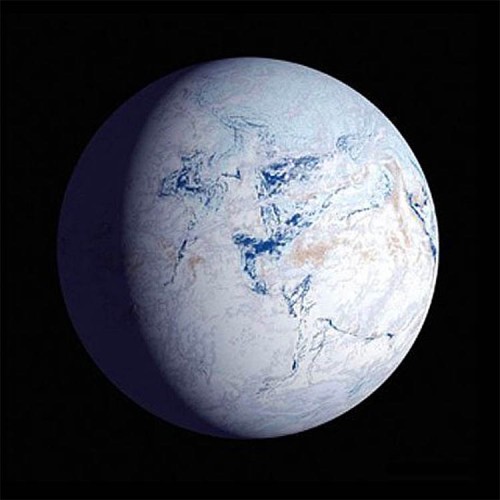The first clear and abundant signs of multicelled organisms appear in the geological record during the 635 to 541 Ma Ediacaran Period of the Neoproterozoic, named from the Ediacara Hills of South Australia where they were first discovered in the late 19thcentury. But it wasn’t until 1956, when schoolchildren fossicking in Charnwood Forest north of Leicester in Britain found similar body impressions in rocks that were clearly Precambrian age that it was realised the organism predated the Cambrian Explosion of life. Subsequently they have turned-up on all continents that preserve rocks of that age (see: Larging the Ediacaran, March 2011). The oldest of them, in the form of small discs, date back to about 610 Ma, while suspected embryos of multicelled eukaryotes are as old as the very start of the Edicaran (see; Precambrian bonanza for palaeoembryologists, August 2006).

Artist’s impression of the Ediacaran Fauna (credit: Science)
The Ediacaran fauna appeared soon after the Marinoan Snowball Earth glaciogenic sediments that lies at the top of the preceding Cryogenian Period (650-635 Ma), which began with far longer Sturtian glaciation (715-680 Ma). A lesser climatic event – the 580 Ma old Gaskiers glaciation – just preceded the full blooming of the Ediacaran fauna. Geologists have to go back 400 million years to find an earlier glacial epoch at the outset of the Palaeoproterozoic. Each of those Snowball Earth events was broadly associated with increased availability of molecular oxygen in seawater and the atmosphere. Of course, eukaryote life depends on oxygen. So, is there a connection between prolonged, severe climatic events and leaps in the history of life? It does look that way, but begs the question of how Snowball Earth events were themselves triggered.
There are now large amounts of geochemical data from Neoproterozoic sedimentary rocks that bear on processes in the atmosphere, seawater, continental crust and the biosphere of the time. Some are indicative of the reducing/oxidising (redox) potentials of ocean water in which various sediments were deposited. Carbon isotopes chart organic burial and the abundance of CO2 in the oceans and atmosphere. Strontium isotopes give details of the rates of continental erosion. The age statistics of zircon grains in sediments are useful; the proportion of zircons close in age to the time of sediment deposition relative to older grains is a proxy for the rate of continental-arc volcanism and thus for subduction rates. Joshua Williams of Britain’s University of Exeter and colleagues from the universities of Edinburgh and Leeds have used complex modelling to assess the pace at which oxygen was added to the surface environment through the Ediacaran Period (Williams, J.J. et al. 2019. A tectonically driven Ediacaran oxygenation event. Nature Communications, v. 10 (1); DOI: 10.1038/s41467-019-10286-x).
They estimate a 50% increase in atmospheric oxygen during the Ediacaran to about 0.25 % of the present concentration, which would be sufficient to support large, mobile animals. They attribute this primarily to a boost in the supply of CO2 to the atmosphere as a result of increased volcanic activity. This would have warmed the surface environment so that exposed rock on the continents underwent accelerated chemical weathering. By freeing from continental crust increased amounts of nutrients, such as phosphorus and potassium, the boost to photosynthesis would have increased the oceanic biomass, thereby emitting oxygen. Multicelled animals would have been beneficiaries of such a transformation. The trend continued into the Cambrian, thereby unleashing the explosion of animals and their evolution that continued through the Phanerozoic. Ultimately, the trigger was increased Late-Neoproterozoic tectonic activity that drove the massive Pan-African orogeny and the accretion of the Gondwana supercontinent.
See also: https://www.sciencedaily.com/releases/2019/06/190619130315.htm
Note added, 26 June 2019: Roger Mason has referred me to the carbon-isotope record during the Ediacaran. It shows some of the stratigraphic record’s largest negative δ13C excursions in carbonate rocks (Tahata, M. and 10 others 2013. Carbon and oxygen isotope chemostratigraphies of the Yangtze platform, South China: Decoding temperature and environmental changes through the Ediacaran. Gondwana Research, v.23, p. 333-353; DOI: 10.1016/j.gr.2012.04.005). Such isotopic excursions went on throughout the Ediacaran, along with sudden fossil appearances and disappearances – so-called ‘Strangelove’ oceans – plus fluctuations in sediment types and climate. The Ediacaran was a wild time in most respects.

Geochemical changes recorded in the complete Ediacaran sedimentary sequence of the Three Gorges of the Yangtze River, China (credit: Tahata et al. 2013; Fig. 4)



































































































